By Michael M. Dugan
A fire is reported at an apartment building in the older section of town. While first-alarm units are responding, the dispatcher contacts them and states, “We are getting numerous calls reporting fire at the location.” The responding members check their gear, pull up their hoods, and get ready to go to work. On arrival, the first-in unit sees that the fire involves the stairway or hallway in the building. If the normal means of travel or the secondary means of escape for the occupants is involved in fire, this fire will require additional help and a coordinated fire attack.
 |
| (1) On arrival, units find that the stairway has smoke showing. This indicates that the fire involves or is possibly impinging on the wooden stairway. The first-in engine company operates the first line to protect the means of egress. (Photos by Gordon J. Nord Jr.)tle risk to members. |
The civilians living in the fire building never think that a fire will obstruct their means of escape in a fire situation, so they never have a backup plan–we are it. That means that responding firefighters and officers may encounter a large number of people in the building needing assistance, depending on the time of day and the number of people in the structure. The more rescues you have to perform, the more resources you will need on scene.
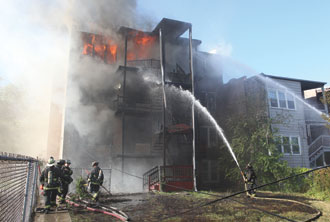 |
| (2) The fire has consumed the rear wooden staircase and has involved the building. The members operating a handline in the rear have to do so from the yard because the stairs are not safe. |
The first-arriving units at a fire involving a means of egress should announce that fact over the radio to all incoming units. The chief will determine if additional units will be required and will strike additional alarms if needed. In most departments, the first-arriving officer might call for additional units on initial size-up.
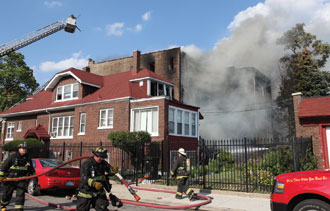 |
| (3) Members stretch another handline to the rear yard for extinguishment and exposure protection. The tower ladder is getting into position to operate. The use of large-caliber streams will help put water on the fire as safely as possible with little risk to members. |
The initial tactic at a fire involving a means of egress is to get water on the fire. This can be done in many different ways, as any good engine company will demonstrate. The question is, Has the fire extended into apartments or living space in the building? If so, you need to protect not only the stairway but also the building. In that case, if the engine company can, it should drop and operate two handlines (staffing permitting). If staffing is an issue, the second engine company or any available firefighter might have to operate the second handline. If you do not have the staffing to operate the two lines, members on the first line will have to determine where the most endangered occupants are and operate to protect them.
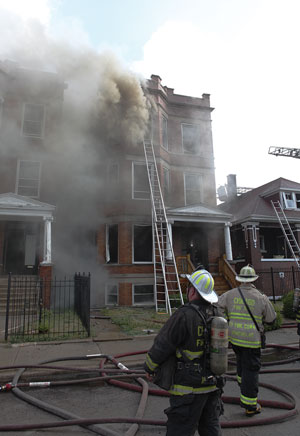 |
|
(4) Members place portable ladders to all floors to expedite searches and to provide a means of egress for operating personnel. |
When stretching, bring enough hose to cover the entire building. Getting water onto the stairway, whether it is an interior or exterior stairway, is one of the most important tasks. Applying water will extinguish the fire and eliminate its spreading into occupied units of the building. The incident commander (IC) must coordinate the engine work to avoid opposing handlines. One line might be operating in the interior of the building and another on the outdoor staircase. If the outdoor line operates into the building, it may change conditions on the interior for the crew operating there. Fast water is going to make the operation much safer for firefighters, the officer, and the public.
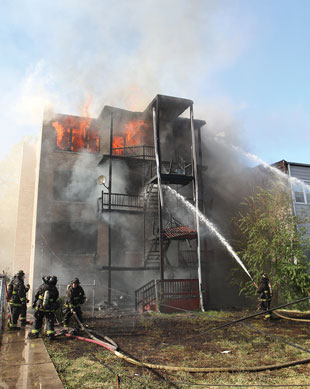 |
| (5) Members deploy additional large-caliber handlines to the rear yard for more knockdown power and prepare to operate those lines. |
The ladder company or members performing search and rescue are going to have their hands full at this type of operation. They will have numerous doors to force, and they will have to search all areas of the structure, which is going to require tools and personnel on every floor. The placement of portable ladders is also critical in these fire situations. A ladder team member or any available member should place ladders to at least every floor that members are working on. The truck crews will have a lot of work to do. They are going to need additional staffing to accomplish all of their tasks and should let command know. They also must inform command of any task assigned to them that they cannot complete. The IC is counting on them to accomplish their assigned jobs. If rescues or building stairway failure will hinder the timely completion of these tasks, they must tell the IC so he can make a contingency plan or reassign the tasks. Communication and coordination will be major factors in a quick knockdown and control of the fire situation.
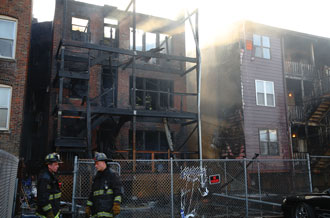 |
| (6) The damage to the building is evident. When the fire starts on or exposes the stairway of a building, the damage to that building increases dramatically. Units might be able to change that through a coordinated operation. |
A few years ago in Brooklyn, New York, there was a rash of fires involving building stairways and public hallways; cities like Chicago and Boston have old buildings with rear wooden decks. A knowledge of your buildings and their layouts will greatly improve your department’s operational efficiency. These fires are difficult and require a lot of resources. Be prepared to deal with a fire involving a means of egress.
MICHAEL M. DUGAN is a 27-year veteran of the Fire Department of New York, where he served as captain of Ladder Company 123 before retiring in 2012. As a lieutenant, he served in Ladder Company 42 and was a firefighter in Ladder Company 43. He has been involved with the fire service for 39 years.
To request information go to fireeng.hotims.com
Fire Engineering Archives

